by Rick Landers
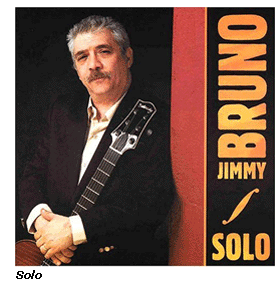 Guitarist Jimmy Bruno has never known life without jazz. When not soaking up jazz guitar from his father, a professional guitarist, his early years were filled with a running lineup of cool cat musicians who dropped by the family home between gigs at local Philadelphia clubs and smokey cafes.
Guitarist Jimmy Bruno has never known life without jazz. When not soaking up jazz guitar from his father, a professional guitarist, his early years were filled with a running lineup of cool cat musicians who dropped by the family home between gigs at local Philadelphia clubs and smokey cafes.
Today, Bruno mesmerizes jazz fans with a mix of traditional and free-jazz guitar chops. He travels the international circuit and holds court as co-chair of the Jazz Guitar Department at Philadelphia’s University of the Arts. After a long stint with highly respected Concord Records, Bruno recently signed with the Mel Bay company’s new label, “Guitar Sessions” and in 2004 released his latest CD, Solo.
I met Jimmy between sets at the Smithsonian Jazz Cafe, a venue that pulls in avid jazz fans every Friday evening near the White House. Leading a quartet, Bruno romanced the crowd with articulate riffs, elegant voicings, and splendid rapid-fire sweeps on his beautiful Sadowsky archtop.
And, don’t miss the full-length mp3 download at the end of the interview, “Benny’s Tune”, from Jimmy Bruno’s lastest CD, Solo.
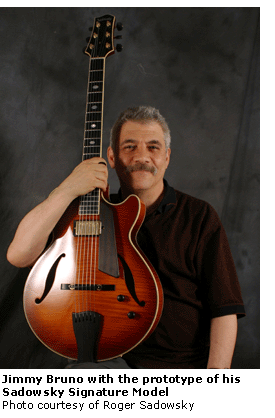 Why jazz? Where do you think you’d be if you hadn’t chosen a life in music?
Why jazz? Where do you think you’d be if you hadn’t chosen a life in music?
Jimmy Bruno: It all starts when my Mom and Dad met back in the 1940s. They were both professional musicians. Dad was a guitarist and Mom was a jazz singer. She was playing in another band and later they ended up playing together in the same band.
Our house was always full of musicians. As a kid, it always seemed like Mom and Dad had parties going on — constantly. But, it wasn’t really like what we’d call a party today, it’s just that musicians would hang out at our house. Mostly they’d sit around and drink coffee and tell jokes until my Dad pulled out his guitar and Mom started singing. Whoever else was there would play and my brother would do his thing on the drums. We were a musical family, so there was always music in the air since as far back as I can remember. I was surprised when I started grade school and found out that everybody didn’t play guitar.
Nat King Cole and Oscar Moore and the whole band would come over back in the mid-1940s, just after the war when the clubs would play continuous music, and I met all of them when they came to the house in the early ’60s when Nat had some hit records. So did members of the Philly Orchestra and a lot of jazz musicians like Sonny Stitt and Billy Bean, who’s another Philadelphia guy. It really was like an open house for musicians and lots of fun.
Would have been hard to not become a musician. I always wanted to be a guitarist, except for a short time when I gave some thought to medical school, but now seeing how high the malpractice suits are going [laughs] I think I’m doing better than some of them.
Let’s go back to when you first picked up a guitar.
JB: I was around 7-years-old when I got my first guitar, although I’m sure I’d been fiddling with them before that age. My first guitar was a big fat-bodied Gibson f-hole. I didn’t like it, I wanted a rock ‘n’ roll guitar – not sure what model, but something like an ES-150.
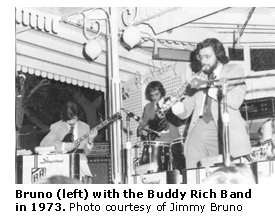
I only had that for a couple of months and then got a Kay acoustic, then a Goya and later one of those cool electric Supras! It was white plastic. Next, I think it was a Guild Starfire when I was about 12 or 13. After that I got a Gibson L-5 and then stuck with Gibsons for a long time.
I’ve always played jazz, though like most kids back then, I had my share of garage bands where we played tunes by the Beatles, Beach Boys and whatever else was popular.
When I was old enough, I moved to Las Vegas and then to L.A. to be a side man for hire and play sessions. I ended up not really liking to play for other people. It was fun in the beginning because that’s what I wanted to do and that’s what you had to do to be successful – go to either Vegas or L.A. to make it. But it didn’t take long for me to dislike that kind of work. I was in Vegas for about two years before I hated it and about three years in L.A. as a session player before I hated that. I liked the areas, just not that type of work.
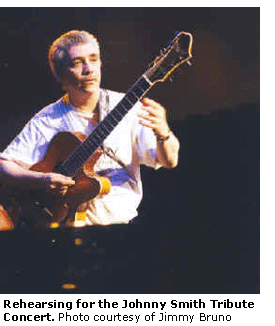
I would meet session guys who were really good at it and didn’t mind playing the same stuff over and over again and the type of work where you weren’t allowed to make mistakes. I did okay, but was never that great at it. In L.A. you got two tries at it with no mistakes.
I played with one guy, Rick Baptist, an incredible trumpet player whom I played with for about eight years in Vegas, and in that whole time I think I only heard him make two mistakes! Rick wanted to be the best lead trumpet player he could be and he took pride in not making any mistakes. We’d play six nights a week, twice a night, and no mistakes. To this day, he’s the first call trumpet player in Los Angeles.
The type of relief-band playing we did back then demanded perfection and was pretty stressful. That really wasn’t where I wanted to be. Besides, I wanted to play jazz. I like improvisation and making it up as I go along. You’re bound to make some mistakes, but then you’re motivated to creatively recover and explore. In Vegas, a lot of the time the playing was sheer boredom followed by four bars of terror because you didn’t want to screw up. You’re playing along and everybody stops and you’re like – aw, shit. I wasn’t great, but I did okay.
There are some exceptional session players now. Guys who are superb at that, like Tommy Tedesco, Tim May and Joe Beck. Joe Beck has gotta be one of the best at doing that.
In your jazz guitar instructional videos you talk about guitarists who write songs that have “no identity”. What does that mean?
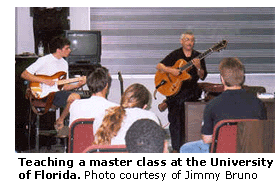
JB: What I meant was the lines they play don’t have an identity, not so much the songs themselves. It’s my opinion that there’s so much information out there about jazz academia, I call it jazz education, that it’s overwhelming for those who want to play jazz. And that’s a sure way to get lost in the whole situation and a sure fire way of getting nowhere when trying to learn.
You really need to find a great teacher or an approach to learning that you like and then stick with it. Stay with one main road of learning. It’s good to explore different ways. You know, there are a million ways to do this, but you can’t do them all and each one is hard. So you have to find someone who’s playing that you like and see what they’re doing. Find out what they’re thinking about and if they teach.
What you’ll find is that a lot of what’s out there is very similar, not radically different. But it’s the whole idea of jazz that has degenerated to the point that it’s been over analyzed, taken apart to the point that, in my opinion, it’s too difficult to figure out and it’s anti-music.
A lot of people suffer from the misconception that you begin by thinking, “If I play these notes over this chord then I’ll make some music.” First you make the music and then, later, sure go ahead and analyze it, but it should only be after the fact, after the music’s been played. You shouldn’t compose by saying to yourself, I’ll start with D Dorian over Dm7. That’s only in the analysis, not in the conception.
Do you know how people learned to play before all of this information was out there? They learned by themselves and found their own way, found their own music voice. I think it’s good that someone can make music and for someone to figure it out, to analyze it — but it’s gotten backwards.
While improvising, do you ever find yourself stuck in a scale box?
JB: I don’t look at it like that. There are 12 notes that get organized in a specific way depending on the chord changes, the harmony, and the harmony can’t exist by itself. I can’t answer the question, “What do you play over G7?” There has to be something in front of it and behind it to put it in context. It’s like the word “here”. It could be “hear”, so you need to know where is it in the sentence, its context. Same thing with a note, where is it in relationship to the tune? For me it’s not scales, maybe riffs.
Once a guitarist learns the scales and the notes on the fretboard, many get stuck on what to do next. The challenge becomes “how do I learn to improvise?” What advice would you give at that stage in the learning process?
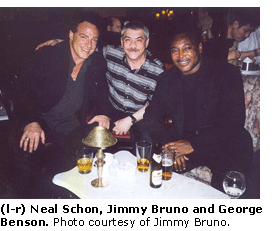
JB: You have to break free from thinking about a certain scale over a certain chord and you have to listen to what you’re playing to really understand the nature of the instrument. I find people sometimes are just moving their fingers and not really listening. You really need to get the chord-scale relationship out of your head. When you’re practicing, experiment with playing the upper parcels. Pick a tune or common chord progression then think of playing the upper parcel and it eventually becomes a new word in your musical vocabulary. So when you practice you need to think about it, but when you play you need to not think about it. Thinking and playing can be 180 degrees apart and I think understanding that would help.
I want to add that guitarists should start with short phrases of melody. For example, take three notes and restrict your playing to only those three notes. How many different melodies can I make with C, D, and E? And then maybe add another note, another half step, an E flat in there and see what that does. You’ll start to get a feel for it and your lines will become more complex and you’ll get more control over your playing as you keep adding long/short/long phrases.
Any advice for those interested in learning jazz guitar?
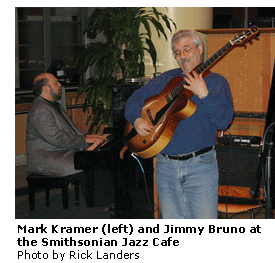
JB: Listen to CDs! First, you need to listen and find someone whose style you like and then see if they have any instructional videos. But, really the first thing to do is listen to some great music – jazz, rock, whatever. And remember, that not every great player is a great teacher. Sometimes you might pick up something from this guy and something different from that guy. Eventually you’ll find your own voice or style.
Another thing that gets screwed up, the other point I want to make, is that with all the “real books” and “fake books” available today, while people learn tunes from them, you can never develop an ear for music with them. If people learn music from CDs they have to really listen, to hear the music. When I was younger we’d all play records over and over again and figure out what the guitarist was playing — note by note.
It really doesn’t take that long if you sit down with a CD player and figure out music the old way. Within two years, most people would have developed a fairly good ear. The education thing is a double-edged sword. The books are great sources for people who can already play guitar, but I think they’re a detriment to someone just starting out who doesn’t really know what chord they’re hearing. When listening to a standard tune, I can tell from the melody what part of the underlying chord it’s coming from, but that’s only because I’ve been doing this for so long and I still listen! I learned it all by ear or someone showed me. I just don’t think learning from books is a good way to start.
Who are some of the great traditional jazz guitarists that have influenced you and are there any young jazz guitarists that impress you?
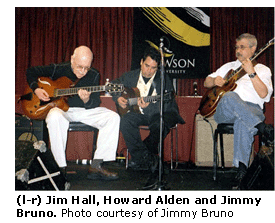
JB: I don’t think I’m qualified to comment on another guitar player’s playing. I will say that people who have influenced me include Johnny Smith, Hank Garland, Joe Pass, Tal Farlow, Wes Montgomery, Howard Roberts, Jim Hall, and Pat Martino, who’s a marvelous Philadelphia guitarist. I’m not really qualified to comment on others. I think anyone making a living playing guitar, whether it’s jazz, rock, or country, and doing what they want to do, must be doing something right. So, they must be good.
For me, I’m so busy I don’t have much time to listen to others playing music, but the few new guys I’ve heard are great. I don’t hear any “bad” guitarists out there and as for those who are stretching the boundaries, I’m all for that.
How do you practice?
JB: Not the same way that I used to when I was just learning. I’m doing music just about 24/7. It’s what I do as a musician.
When I get up, it’s music and the computer, then I find my way to the home recording studio. I also teach and have some private students that come to my house for instruction. I’m always involved with music and playing.
I teach one day a week at the University of the Arts in Philadelphia when I can, and have helped design some curriculum. I’ve enjoyed working with a great guitarist at the school, who’s also the co-chair of the Guitar Department, Tom Giacabetti. Tom’s my guitar hero! He can play any kind of music and he’s the “first call” guitarist in town. He plays mandolin too. When a player needs to read a classical piece, he’s the guy. Tom can transcribe music as it’s being played without a guitar in front of him.
You’ve recently moved to the new Mel Bay “Guitar Sessions” label from a long relationship with Concord Records. What are your plans with the new company?
JB: I don’t think I burned any bridges when I moved from Concord to Mel Bay’s Guitar Sessions label. I expect that I’ll record again with Concord sometime in the future. Bill Bay started a great new “Guitar Sessions” label and has been doing a lot to promote it and the musicians that have joined him. He’s done a lot for me with my new CD, Solo.
And back to Concord, I want to add that if it wasn’t for Concord, Bill Bay wouldn’t know who I am. When I first started out with Concord they spent a lot of money promoting me, but companies are like people, they change and move on to different things. Right now, I’m focusing my attention on Bill Bay’s label and am very happy about it.
You have a close relationship with guitar builder Robert Benedetto.
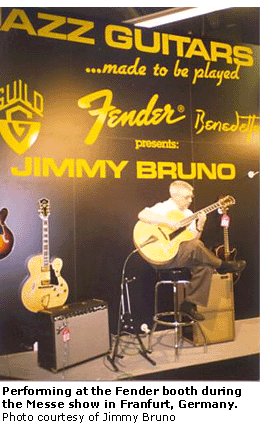
JB: That whole Jimmy Bruno guitar model saga went on for maybe 5-6 years. It started with Bob Benedetto on my first CD. I’ve known Bob and Cindy Benedetto for 15 years. He wanted to make a guitar for me and wanted me to take a look at his guitar. As you can imagine, Bob’s guitars are pieces of art. Anyway, he wanted me to try out his personal guitar and tell him what I liked and what I didn’t like so he could improve it and build one for me. I liked the guitar he showed me so much he gave it to me!
Then I moved to a Howard Alden model and next a 7-string made by Bob. I wanted a little guitar, so I started playing something smaller with a built-in pickup and he made me a six-string like that. I played Benedettos for fifteen years. They’re magical.
Later, Bob got involved with the Fender-Guild people and we talked about a Jimmy Bruno 6-string model, but Fender wanted a 7-string. Well, whatever Bob touches is beautiful and the guitar was fine. I had some differences about how I thought the guitar should be marketed. Fender and I just had a professional disagreement. We’re all still friends and I think they’re great guys. We just disagreed on how to market the model. They’ve been selling guitars for a long time and, well, my heart was in another place. I just preferred something different and we parted on good terms. I stayed with six-strings. I didn’t miss the extra notes on the 7-string guitars. It was a bit depressing not being associated with Bob Benedetto, but he perfectly understood and he and his lovely wife, Cindy, and I are still close friends.
After that, Hofner approached me about a Bruno model and made some fine instruments. But nothing was like when I picked up my first Benedetto. It just clicked. I’ve played a lot of name brand guitars, great guitars, but when I picked up Bob’s there was magic and that was it. And that’s what the Hofner didn’t have, not that it wasn’t a nice guitar, it was. The connection just wasn’t there the way Bob’s guitars grabbed me. So, every one of these things takes time, they all take time to design and build, and after awhile I just got tired of the whole endorsement thing.
And the new Jimmy Bruno Sadowsky model?
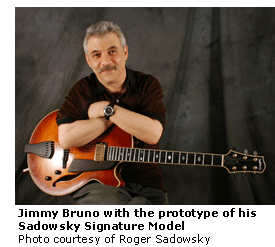
JB: Last summer [2004] I was at the 1st Guitar Congress in Towson, Maryland, and was getting ready to go on stage to play a solo set. I bumped the bridge of the Hofner and couldn’t fix it right away and got a little frantic. Then I happened to pass Roger Sadowsky’s booth and he had this beautiful Jim Hall Signature model there and I asked if I could use it. Roger said, “Sure,” and as soon as I played it, before I finished the first tune, I said to myself, “This is the guitar!”
Isn’t the Sadowsky Jim Hall Signature model a laminate?
JB: Yes, it’s got a laminated body and that kind of surprised me, but also pleased me. It was the type of guitar I wanted my name to be associated with because it would be much more affordable than a carved model and I always felt that once you plug them in, a laminate might be better than the expensive carved guitars.
Don’t get me wrong, a carved guitar is great to record with, but a laminate is more rugged and more suited to take the bumps on the road. They hold up better and if they’re made right, it’s easy to get a good jazz sound out of them. Look at the Gibson ES-175.
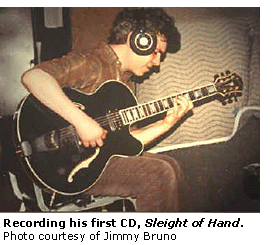
Anyway, I just fell in love with Roger’s guitar and we talked about a laminated Jimmy Bruno model. Within six weeks, he had a prototype in my hands and we took it to the 2005 Winter NAMM Show last month. It was perfectly playable. We’ll make a few minor changes to the prototype, like changing the shape of the inlays and making it a bit smaller. I think the colors will be violin, tobacco, blonde and something else. There’s a fourth finish, I don’t remember what it is right now, but go to the Sadowksky website and all the specs are there.
It’s a small guitar with a built-in pickup and it’s perfect for the road. I plug in to a Raezer cabinet with an Acoustic Image amp. That’s my rig most of the time. I sometimes use a Kotch, a marvelous, powerful amplifier that can play both clean like an old Fender Twin or dirty. I only use half of it since I like to play clean. I also have a nice tube amp that George Allesandro and Bill Comins designed. Dr. Rick Jones at Acoustic Image recently designed a very small amp that’s also cool. It’s the size of a digital camera with the same watts as their bigger model. Incredible.
Jazz boxes tend to be expensive. What guitar would you recommend to a new player?
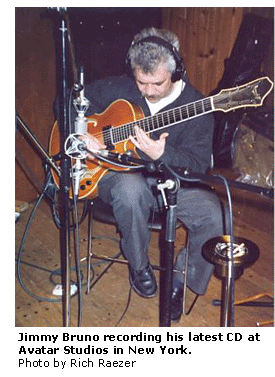
JB: My best advice to young guitar players who want a jazz guitar is, if they can afford it, to get a really good laminate guitar, the best they can find. The trend now has all the top makers offering laminate models and that seems to be the way things are going.
I’m a bit biased, but I think Roger Sadowsky’s Jimmy Bruno model is the best one out there. Like I said earlier, as soon as I touched one of his laminate guitars, I fell in love with it. Somehow I always felt like I was looking for a good laminate.
Sometimes in the real world, an expensive carved jazz guitar seems wasted. Sure they sound superb in a recording situation, but taking one on the road can be tough – you worry about them too much. Why not just get a quality laminate that will sound good anywhere, one that will always sound like a jazz guitar in a large or small hall?
With my new Roger Sadowsky Bruno model I use strings designed by Roger and made by La Bella. I use my own signature set that’s made up of gauges I prefer: .13, .17, .25, .32, .42, and .52. I’ve almost always used La Bella strings, probably because that’s what my father had on his guitars. It was great to meet the La Bella folks too. That’s one of the bonuses when you get some name recognition.
Roger was great, by the way, in building the guitar and designing the strings. I’d say something like, “It’s fine,” and he’d say, “No, I want you to go ‘wow!'”. So Roger, the perfectionist, is always working toward “wow”, and I love that kind of dedication.
Have you noticed any greater appreciation for jazz guitar during the last few years? Is there some grassroots jazz movement afoot?
JB: Well, yes and no. I wouldn’t say jazz music is growing as a whole. It’s better to say that it’s growing in a lot of different directions at once. The meaning of the phrase “jazz guitar” has changed. Jazz guitar in the year 2005 doesn’t mean what it did in the 80s, and it had even different meanings in each previous decade and the word “jazz” in the 1950s was a lot different than the meaning of the term today. Jazz is getting broader, though that’s a double-edged sword with pluses and minuses.
Any plans for the next CD or DVD?
JB: Right now, I have two or three projects floating around that I’ve already started. I’ve got the beginnings of another solo CD, but I’m not sure Bill Bay will want to release another solo album so soon after the recent release. Maybe Concord would be interested or I could issue it myself as a downloadable release from my website.
Your website has a lot to offer, including some music downloads and a couple of jazz instruction modules.
JB: You know, I think the Internet is the future of the record business and that the disc idea will be gone within the next ten years or so unless maybe the consumer industry can get the costs down on the new high-end Super Audio CD systems that are very expensive at the moment. If and when that becomes the norm, maybe record companies will have a shot at selling CDs again. In my opinion, the old “brick and mortar” shops are on the way out. The Internet has already changed the world and a lot of people still don’t get it. It’s a new frontier and it’s already here.
_____
MP3 download (Zip file)
“Benny’s Tune” by Jimmy Bruno
[Sound file offered with the permission of Mel Bay Publications, BMI/Jimmy Bruno Music, BMI. All rights reserved.]
_____
Related Links
Jimmy Bruno: www.jimmybruno.com
Mel Bay Records: www.melbayrecords.com
Sadowsky Guitars: www.sadowsky.com
Benedetto Guitars: www.benedetto-guitars.com
Smithsonian Jazz Cafe: www.mnh.si.edu/jazz
Raezers-Edge: www.raezers-edge.com
Acoustic Image: www.acousticimg.com/index2.html
Alessandro: www.alessandro-products.com/amps.html
University of the Arts: www.uarts.edu